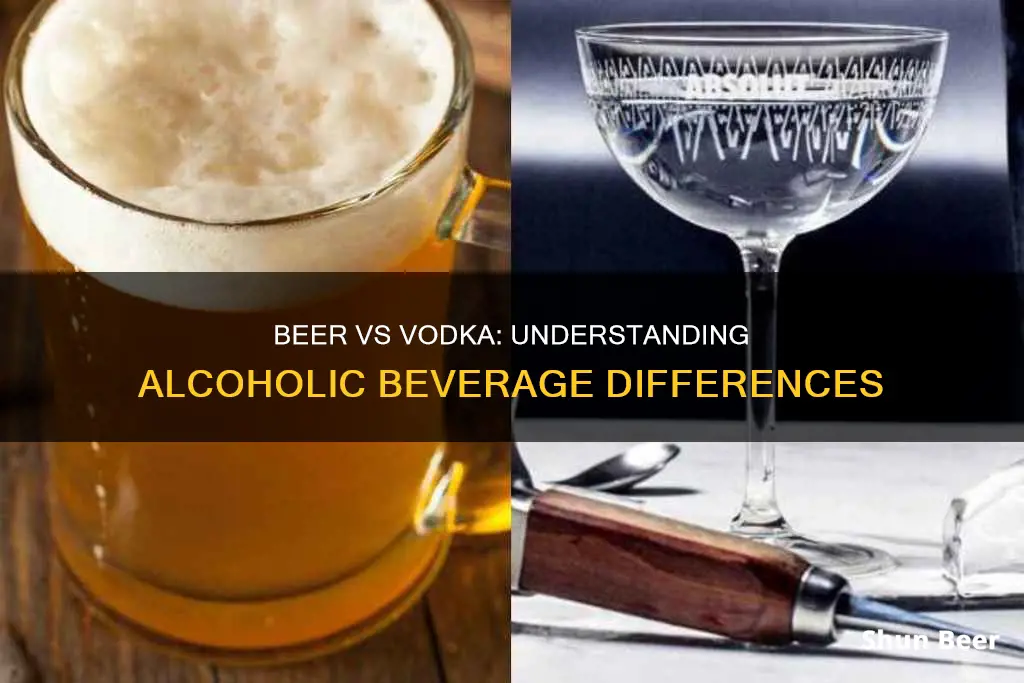
Vodka and beer are two of the most commonly consumed alcoholic beverages in the world, with distinct differences in terms of their history, production, taste, and cultural significance. Vodka, a distilled spirit, is typically made from grains, potatoes, or fruits and boasts a high alcohol content, usually around 40% ABV. Beer, on the other hand, is a fermented beverage, often brewed from malted barley, hops, yeast, and water, resulting in a lower alcohol content, typically ranging from 4% to 6% ABV. While vodka is known for its neutral flavour profile and versatility in cocktails, beer offers a wide range of flavours, from bitter IPAs to sweet stouts, and is favoured for casual drinking and social gatherings.
Differences Between Beer and Vodka
| Characteristics | Values |
|---|---|
| Alcohol Content | Vodka has a higher alcohol content, typically around 40% ABV, while beer ranges from 4% to 6% ABV for popular lagers and ales. |
| Production Process | Vodka is distilled multiple times from grains, while beer is a fermented beverage brewed from malted barley, hops, yeast, and water. |
| Calorie Content | Vodka has fewer calories than beer, making it a better option for those conscious about their weight. |
| Flavour | Vodka often has a neutral taste profile, while beer offers a wide range of flavours, from bitter IPAs to sweet stouts. |
| Alternative Uses | Vodka has alternative uses, such as cooking and disinfecting wounds, while beer is primarily consumed as a drink. |
| Cardiovascular Health | Excessive beer consumption can negatively impact cardiovascular health, whereas vodka, in moderation, can improve heart health by reducing cholesterol levels and promoting healthy blood circulation. |
| Temperature Sensitivity | Vodka is suitable for cold weather as it can be mixed into warm drinks, whereas beer is associated with hot weather and is not ideal for breakfast or lunch. |
| Mouthfeel | Vodka provides a smooth and warming mouthfeel, while beer can range from light and crisp to full-bodied and creamy, with carbonation adding a prickly sensation on the tongue. |
| Origin | Vodka originated in Russia or Poland, while beer is believed to have originated in Ancient Mesopotamia or Germany. |
What You'll Learn

Vodka is distilled, beer is fermented
Vodka and beer are two different types of alcoholic drinks with distinct production processes, origins, flavours, and cultural significance. One of the key differences between the two is that vodka is distilled, while beer is fermented.
Vodka is distilled
Vodka is a distilled spirit, which means it undergoes a distillation process after the initial fermentation. Distillation involves heating a mixture to evaporate its components and then condensing the vapours to purify and separate the desired component. In the case of vodka, distillation serves to increase the ethanol content and achieve a high level of purity. Vodka is typically distilled multiple times, sometimes up to six occasions, to reach its characteristic high alcohol content and smooth mouthfeel.
Beer is fermented
Beer, on the other hand, is a fermented beverage. Fermentation is a process where yeast or bacteria chemically converts sugar into ethanol. In the context of beer, the sugars in malted barley, or other grains, are fermented, resulting in the production of alcohol and carbonation. This single-step fermentation process sets beer apart from distilled spirits like vodka.
Impact on flavour and alcohol content
The distillation process in vodka production is responsible for its high alcohol content, typically around 40% ABV, and its neutral flavour profile. Vodka often has subtle hints of grain or potato, depending on the base ingredient used. The repeated distillation and filtration processes remove impurities and flavours, resulting in a clear, odourless, and flavourless liquor.
In contrast, beer has a much lower alcohol content, usually ranging from 4% to 6% ABV for popular lagers and ales. The fermentation process in beer production imparts a broader spectrum of flavours, ranging from bitter IPAs to sweet and malty stouts. The use of different hops, malts, and brewing processes further contributes to the complex and varied flavours found in beer.
Other differences
The differences between vodka and beer extend beyond distillation and fermentation. Vodka, often considered a harder drink, has a longer shelf life and can be consumed at any time of day. It is commonly used in cocktails or enjoyed neat, particularly in Eastern European countries. Beer, on the other hand, is favoured for casual drinking scenarios and is widely consumed straight from the bottle or on draft. It has a shorter shelf life and is typically associated with social gatherings, sporting events, and pub culture.
Beer vs Lager: What's the Difference?
You may want to see also

Vodka has fewer calories
Vodka has a lower calorie count than beer. A regular 12-ounce beer contains about 150 calories, whereas the same amount of vodka contains only 100 calories. A tallboy (64-ounce) beer can contain up to 260 calories, while a regular serving of vodka has only 80 calories. Vodka's distillation process, which leaves only alcohol, is responsible for its reduced calorie content. Conversely, beer is a high-calorie beverage due to its fermentation process.
Vodka is a better option for those trying to lose weight or watching their calorie intake. Beer calories can quickly turn into fat, especially when paired with a high-calorie diet. Vodka, on the other hand, has about a quarter of the carbs and is low in calories, so it does not contribute to weight gain. It can be easily mixed with other beverages to create cocktails, providing a variety of low-calorie options.
Vodka's lack of flavour also contributes to its lower calorie count. It is distilled multiple times until it is flavourless and odourless, whereas beer has a vast spectrum of flavours, ranging from bitter IPAs to sweet and malty stouts. The distillation process removes impurities and leaves only alcohol, resulting in a pure and potent drink. This also makes vodka more versatile, as its neutral taste profile and subtle aroma make it ideal for mixing in cocktails.
Vodka's distillation process not only reduces calories but also increases its alcohol content. Vodka typically has an alcohol content of around 40%, while beer usually ranges from 4% to 6%. This means that a single shot of vodka (1.5 ounces) can contain the same amount of alcohol as an entire 12-ounce beer. Therefore, drinking beer to match the effects of vodka could lead to consuming more calories. However, it is important to note that binge drinking either beverage can be harmful, and the higher alcohol content in vodka can lead to excessive alcohol consumption more quickly.
Cider vs Beer: What Sets Them Apart?
You may want to see also

Vodka is flavourless, beer has a spectrum of flavours
Vodka and beer are vastly different beverages, with distinct flavour profiles. Vodka is flavourless, with a neutral taste and subtle aroma, while beer offers a spectrum of flavours, ranging from bitter IPAs to sweet and malty stouts.
Vodka is distilled multiple times, and the repeated distillation process is what gives vodka its flavourless character. Vodka is distilled from grains, including wheat, rye, and potatoes, and contains about 40% alcohol. The distillation process removes impurities, leaving behind a pure, flavourless liquor. Vodka is often described as "tasteless" and "odourless", with a subtle burning sensation due to its high ethanol content. Its neutral flavour makes it a versatile component in mixed drinks and cocktails.
In contrast, beer is a fermented beverage, brewed from malted barley, hops, yeast, and water. The fermentation process gives beer its distinct flavours and aromas, which can range from fruity and floral to yeasty and roasted. Beer also has a more complex mouthfeel than vodka, ranging from light and crisp to full-bodied and creamy, with carbonation adding effervescence and prickliness on the tongue.
The difference in production methods, with vodka being distilled multiple times and beer undergoing a single fermentation process, results in the distinct flavour profiles of these two beverages. Vodka's distillation removes flavour, leaving behind pure alcohol, while beer's fermentation imparts a range of flavours and aromas, contributing to the varied expressions that make each beer unique.
While vodka's flavourless nature makes it a versatile spirit that can be mixed with other beverages or enjoyed neat, beer's flavourful character makes it a favourite for casual drinking scenarios, often enjoyed straight from the bottle or on draft. The spectrum of flavours in beer, from bitter to sweet, light to full-bodied, ensures that there is a beer to suit a variety of tastes and preferences.
Exploring the Diverse US Beer Scene
You may want to see also

Vodka is typically stronger
The higher alcohol content in vodka means that excessive alcohol consumption can occur more quickly, as a single shot of vodka (1.5 ounces) can contain the same amount of alcohol as an entire beer (12 ounces). Vodka is often consumed neat or in shots, and its high alcohol content and neutral flavour make it a popular choice for cocktails.
The production processes of vodka and beer also differ significantly. Vodka is distilled multiple times to achieve its high alcohol content and purity, while beer undergoes a single fermentation process. The fermentation process for beer involves yeast metabolising sugars from malted barley to produce alcohol and carbonation. Vodka, on the other hand, is distilled to elevate the ethanol content after the initial fermentation of sugars into alcohol.
The distinct production methods and alcohol content contribute to the different characteristics of vodka and beer. Vodka is known for its neutral taste profile, often with subtle hints of grain or potato, while beer offers a wide range of flavours, from bitter IPAs to sweet and malty stouts. Vodka's aroma is typically subtle and clean, complementing its overall neutral character, whereas beer's aroma presents a complex range of scents influenced by the specific hops, malt, and brewing process.
In terms of mouthfeel, vodka provides a smooth and warming sensation, especially when consumed neat, while beer can vary from light and crisp to full-bodied and creamy, with carbonation adding effervescence or prickliness on the tongue.
Stroh's Beer: Unique Characteristics and Distinctions
You may want to see also

Vodka is a cocktail component, beer is usually drunk casually
Vodka and beer are two distinct types of alcoholic beverages that differ in various ways, including their production methods, flavour profiles, cultural significance, and the occasions they are typically consumed. One of the key differences is that vodka is often used as a cocktail component or mixed with other drinks, while beer is frequently favoured for casual drinking scenarios.
Vodka, a distilled spirit, typically contains a higher alcohol concentration, usually around 40% ABV, and can go up to 50% or more in some varieties. It is made by distilling grains such as wheat, rye, or potatoes, resulting in a clear, odourless, and flavourless liquor. The distillation process removes impurities and flavours, giving vodka its neutral taste profile. This makes vodka an extremely versatile component in mixed drinks, as it can be combined with other ingredients to create a wide range of cocktails like the Bloody Mary, Cosmopolitan, or White Russian. Vodka can also be consumed neat, chilled, or as a shot, often as part of social rituals.
On the other hand, beer is a fermented beverage with a much lower alcohol content, typically ranging from 4% to 6% ABV for popular lagers and ales. It is brewed from malted barley, hops, yeast, and water, and can include adjuncts like corn or rice to adjust flavour and calorie content. Beer has a complex flavour profile, ranging from bitter IPAs to sweet and malty stouts, and a distinct mouthfeel that can be light and crisp or full-bodied and creamy. Carbonation also plays a crucial role in beer's mouthfeel, adding effervescence and prickliness on the tongue. Beer is widely consumed straight from the bottle or on draft and is a staple at social gatherings, sporting events, and casual drinking occasions.
The difference in alcohol content between vodka and beer is significant. A single shot of vodka (1.5 ounces) can contain the same amount of alcohol as an entire beer (12 ounces), depending on the specific types compared. This means that while beer may seem like a lighter option, drinking multiple beers to match the alcoholic buzz from vodka can lead to consuming more liquid and, consequently, more calories. Additionally, the higher alcohol content in vodka can lead to excessive alcohol consumption more quickly compared to beer.
In terms of occasions, vodka is often chosen for its versatility. It can be consumed neat in Eastern European and Nordic countries, but it is also commonly used as a base for cocktails or mixed drinks. Vodka's neutral flavour and high alcohol content make it a popular choice for creating a variety of cocktails. Beer, on the other hand, is deeply ingrained in many cultures and is often consumed casually, whether at social gatherings, sporting events, or simply unwinding with friends. Beer has a longer history and is considered the oldest alcoholic drink, dating back to Ancient Mesopotamia. It has become a part of pub culture and is often enjoyed as a casual drink, straight from the bottle or on draft, encouraging slower consumption over a longer period.
Learn to Order Beer in Many Languages
You may want to see also
Frequently asked questions
Vodka is a distilled drink, while beer is fermented. Vodka is made from grains, like wheat, rye, or potatoes, and has a higher alcohol content, typically around 40% ABV. Beer is brewed from malted barley, hops, yeast, and water, and has a lower alcohol content, usually around 4-6% ABV.
Beer is believed to be the oldest alcoholic drink, originating in Ancient Mesopotamia over 3900 years ago. Vodka, on the other hand, originated in the mountains of Poland and Russia, first appearing in a court document from 1405.
Vodka has a lower calorie count than beer. For example, a 12-ounce beer typically contains about 150 calories, while the same amount of vodka contains around 100 calories. Excessive beer consumption can negatively impact cardiovascular health, while moderate vodka consumption may improve heart health by reducing cholesterol levels and promoting good blood circulation.







